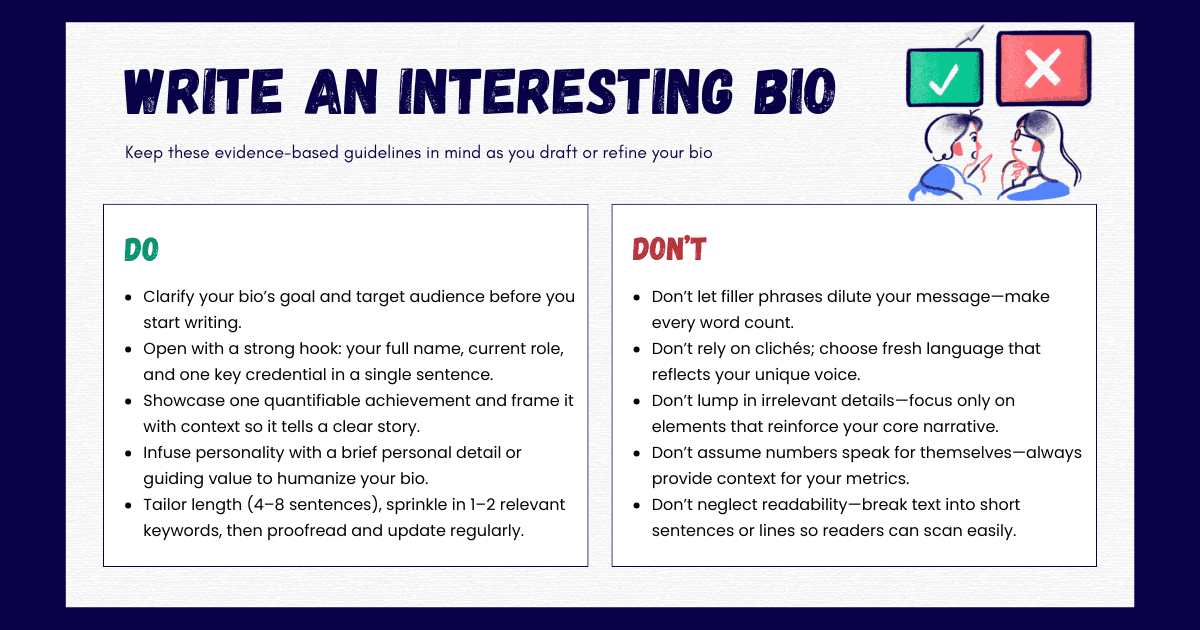Ever felt hiring managers or potential clients are scrolling past your profile without a second glance?
Readers size you up in the blink of an eye, and most hiring managers will scan your online profile long before a handshake ever happens. That makes your short professional bio far more than background text—it’s the gateway to every interview, contract, and collaboration you hope to secure. This guide walks you through writing one that instantly earns a second look.
In the next section, we’ll define exactly what a “short bio” is and why it matters, so you can start crafting yours with confidence.
ᴀᴅᴠᴇʀᴛɪsᴇᴍᴇɴᴛ
What is a Short Bio?
A short bio is a tight, one-to-three-sentence snapshot of your career story. It tells readers who you are, what you do, and where you’re headed—all before they scroll. You’ll see it in LinkedIn “About” sections, company directories, speaker bios, and even email signatures. Because employers and clients skim first and decide later, a short bio works like your elevator pitch on autopilot, opening doors while you’re busy elsewhere.
You can also read, How to Write a Postcard.
What to Include in a Short Bio
Here’s what every standout bio needs—no filler, just the essentials:
-
Name & current role: Lead with your full name and present job title to anchor the reader.
-
Professional background: A single credential or experience that signals expertise.
-
Signature achievement: One measurable win that proves you deliver results.
-
Future focus: A forward-looking phrase that shows where you’re headed next.
-
Personal touch: A brief hobby or cause that humanises the blurb.
Cover these five points, and you’ll have a bio that recruiters and clients can grasp at a glance, setting you up perfectly for the step-by-step template that follows.
How to Write Your Bio, Step by Step
Use these five key phases to craft a bio that’s tailored, concise, and instantly engaging across any platform.

1. Plan Your Bio
Decide who will read your bio and choose a consistent first- or third-person voice to set clear expectations.
-
Define audience and purpose: Ask yourself, who will read your bio? and what do you need it to achieve? Tailoring your message to your audience with a defined purpose ensures every word resonates and guides their next step.
-
Choose a voice: Select a voice and narrative for your bio and stick to it. Choose first-person (“I lead product strategy…”) for a conversational touch on social media or third-person (“Jordan leads product strategy…”) for formal settings like executive bios and speaker pages. Consistency in perspective builds credibility and clarity.
2. Establish Credibility
Open with your full name, current role, and one standout credential to anchor your expertise immediately.
-
Lead with your name and job title: Start with your full name and current role—e.g., “I’m Maya Khan, Senior Product Manager at BrightWave.” This anchors readers immediately and sets the stage for deeper details about your expertise and responsibilities.
-
Add a credibility clause: Include one key credential—a degree, certification, or years of niche experience, such as “with a Master’s in UX Design from Stanford and over eight years in fintech.” A well-placed credential lends instant authority without overwhelming detail.
3. Showcase Impact
Highlight a single measurable achievement and state what you’re working on next to demonstrate both track record and ambition.
-
Showcase one signature achievement: Highlight a specific, measurable result—“increased user retention by 30%” or “published three peer-reviewed articles”—to provide concrete proof of your impact. Use numbers or accolades to quantify success whenever possible.
-
Point to your future focus: Briefly describe what you’re working on next—launching an AI-driven feature, leading cross-functional innovation, or mentoring emerging talent. Forward-looking aspirations signal ambition and give readers a clear sense of your evolving career path.
4. Humanize Your Bio
Add a brief personal detail—like a hobby or passion—to make you memorable and spark a genuine connection.
- Add personal detail: Close with a human detail—“weekend trail runner” or “coffee aficionado and amateur photographer”—to make you memorable and relatable. Keep this nugget under eight words to maintain brevity and spark natural conversation starters.
- Share core value: Include a guiding principle or cause, like “advocate for inclusive design”—to show what drives you beyond the day job.
5. Optimize and Maintain
Tailor length, tone, and keywords for each platform, keep it to about 80–150 words, and routinely proofread and update with peer feedback.
-
Optimize for platform & keywords: Adjust length and tone to fit platform limits (LinkedIn summaries allow up to 2,600 characters; Twitter caps at 160). Sprinkle one or two relevant keywords naturally—for example, “data visualization” or “content strategy”—to boost SEO and recruiter searchability.
-
Maintain concise length: Aim for four to eight sentences (roughly 80–150 words)—the sweet spot for clarity and attention, per career experts at Indeed. Each sentence should advance your narrative, so trim filler words and redundant phrases without losing personality.
-
Review, proofread & update regularly: Read your bio aloud to catch awkward phrasing, grammatical hiccups, or inconsistent voice. Use our Grammar Checker to eliminate any mistakes. Update your bio whenever you hit milestones—promotions, awards, new skills—or at least every six months to keep it fresh and accurate.
-
Get feedback & iterate: Share your draft with a trusted colleague or mentor to ensure it reads well and aligns with professional expectations. Third-party feedback often uncovers blind spots and helps you refine tone, clarity, and impact.
Use this five-part framework as your blueprint—adapt each phase to your field and career level, then move on to the templates and real-world examples that follow to bring your bio to life.
ᴀᴅᴠᴇʀᴛɪsᴇᴍᴇɴᴛ
Short Professional Bio Examples
Below are three sample bios that follow expert guidance—each is concise, authentic, and structured for maximum impact. Career authorities agree that a professional bio typically works best in four to eight sentences, balancing brevity with enough detail to engage readers.

-
Example 1:
Alex Martinez is a digital marketing strategist with over eight years of experience in SEO and content marketing. He led campaigns that boosted client engagement by 150%. Alex is passionate about leveraging data-driven strategies to drive business growth.
-
Example 2:
I’m Priya Desai, a software engineer specializing in mobile application development. With a background in computer science and a knack for user-centric design, I create apps that make everyday tasks easier. Outside of work, I enjoy hiking and exploring emerging technologies.
-
Example 3:
Jordan Lee is a certified financial planner dedicated to helping young professionals manage their finances effectively. He has helped clients save an average of 20% more on annual expenses through personalized strategies. Jordan believes in making financial literacy accessible to all.
Each example uses the recommended sentence count, clear language, and a personal touch to make you memorable.
Read our article on “You Should Know 11 Grammar Rules that are often Broken” to avoid common mistakes and sound professional in your writing.
Professional Bio Templates
Use these adaptable frameworks as a starting point—fill in your details and adjust the tone to match your brand:
-
General Professional Bio Template
“[Your Name] is a [Your Job Title] with [Number] years of experience in [Industry]. Specializing in [Expertise], [he/she/they] has contributed to [Notable Achievement]. Currently at [Company], [he/she/they] focuses on [Key Responsibilities]. Outside work, [Your Name] enjoys [Personal Interest].”
-
Short Bio for Social Media or Networking
“I’m [Your Name], a [Your Job Title] passionate about [Key Interest] and skilled in [Top Skill]. Let’s connect on [LinkedIn/Twitter] to share ideas and opportunities.”
-
Student or Recent Graduate Bio
“[Your Name] is a recent graduate from [University] with a degree in [Field]. During studies, [he/she/they] completed [Project or Internship], developing skills in [Relevant Skills]. Now eager to apply these strengths in [Target Industry or Role].”
These templates reflect best practices—concise structure, clear labels, and a hint of personality—so you can craft a standout bio in minutes. Choose the format that fits your goals, plug in your specifics, and you’re ready to make a memorable first impression.
For more insights on personalizing your bio for social media, check out our article on “Creative Uses of Small Text Generators for Social Media”.
Short Bio Writing Tips
Keep these evidence-based guidelines in mind as you draft or refine your bio.

-
Be Concise in Your Bio
Aim for four to eight sentences (about 80–150 words) so readers can grasp your story at a glance. Excess length risks a drop-off.
-
Be Genuine About Yourself
Authenticity builds trust. Use your true voice and only include accomplishments you can back up.
-
Be Clear and Informative
Avoid jargon and overly complex terms. Focus on plain-English descriptions that your audience will immediately understand.
-
Avoid Grammatical Mistakes
Use clear, correct grammar to sound professional—run your bio through a grammar checker tool to catch typos, punctuation errors, and awkward phrasing before you publish.
-
Be Relevant to Your Niche
Tailor your content to the platform and sprinkle in one or two keywords according to your industry or niche, like “content strategy” or “UX design”—to help recruiters and clients find you.
-
Be Bold and Creative
Optionally, you can highlight a few words with fancy text, especially for social media bios. Use our Small Text Generator to create unique text styles and stand out.
Following these principles ensures your bio stays sharp, trustworthy, and easy to read.
How to Write a Bio FAQ
Below are concise answers to the questions professionals frequently ask when crafting their bios, backed by expert guidelines and studies.
What’s the Best Way to Start My Bio?
Begin with your full name and current job title to orient the reader immediately. Including “Job title or workplace” right off the bat ensures clarity from the first sentence.
What Exactly Is A Short Professional Bio?
A short bio is a concise, one-to-three-sentence snapshot of your background, skills, and aspirations. It works like an always-on elevator pitch—quick enough to scan, substantial enough to engage.
How Long Should My Bio Be?
Aim for four to eight sentences (around 80–150 words). This length balances brevity with enough detail to showcase your expertise without losing reader interest.
First-Person Or Third-Person—What’s Better?
Use first-person (“I lead…”) for a conversational tone on social media and personal sites; opt for third-person (“Alex leads…”) in formal contexts like press releases or speaker pages. Consistency in perspective builds credibility.
How Do I Blend Professionalism With Personality?
Lead with your role and a key achievement, then add one personal detail—such as a hobby or core value—to humanize your bio. Mixing professional highlights with personal interests makes your story both credible and relatable.
How Often Should I Update My Bio?
Treat your bio as a living document: revise it after major milestones (promotions, awards, new certifications) or at least every six months to keep it fresh and accurate.
Should I Include Seo Keywords?
Yes—naturally weave one or two relevant keywords (e.g., “content strategy,” “UX design”) into your bio. This helps improve discoverability without sacrificing readability.
What Pitfalls Should I Avoid?
Avoid clichés, industry jargon, and overly long sentences. A dry, resume-style bio can lose readers—focus instead on clear language, concrete results, and a single humanizing touch.
ᴀᴅᴠᴇʀᴛɪsᴇᴍᴇɴᴛ
Key Takeaways
-
Your bio is your digital handshake. A concise, one-to-three-sentence introduction sets the tone for every professional interaction.
-
Cover five core elements. Lead with name & role, signal credibility, showcase impact, hint at where you’re headed, and add a human detail.
-
Follow a clear framework. Plan your audience, establish credibility, demonstrate results, humanize your story, then optimize and maintain.
-
Use the right tools. Draft with our templates, polish with the Grammar Checker, and verify originality with the Plagiarism Checker.
-
Keep it fresh. Refresh your bio after major milestones or at least every six months to stay relevant and engaging.
Related Articles
- Also read: When to Capitalize Job Titles
- Also read: How to Write a Preface: A Guide for Authors with Examples
- Also read: 3 Ways How E-Signature Improves Customer Experience







